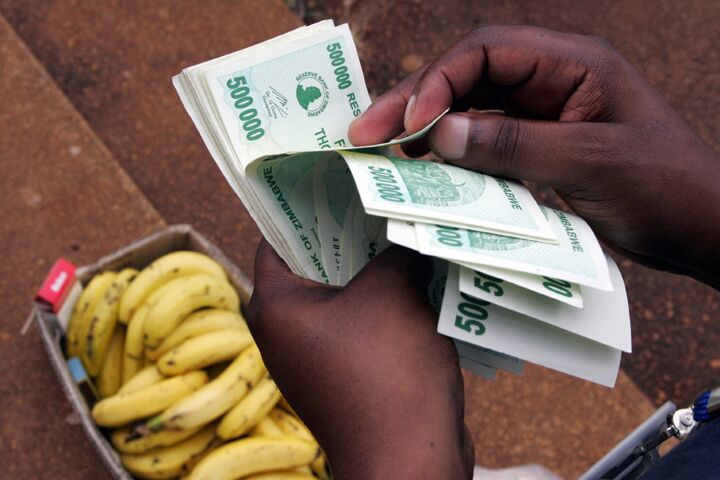
Is Zimbabwe-style Inflation Coming to America?
In Zimbabwe, inflation is measured by the hour, not month-over-month as in America and the rest of the developed world.
Zimbabwe’s few remaining merchants update their price tags four, five, or more times a day—that is, when shipments arrive on time, or haven’t been hijacked. For many people, life is a struggle just to get their paycheck to the store quickly enough so that it doesn’t lose value before it can be spent. Life is even harder for the millions who no longer have jobs at all—destroyed by an economy in meltdown.
A report released by Zimbabwe’s Central Statistical Office indicates that the inflation rate for the month of January, as measured by the All-items Consumer Price Index, stood at a practically incomprehensible 100,580 percent.
As gigantic as that number is, most Zimbabweans don’t bother with the official statistics these days (and independent observers believe the true figures are even higher). For many people all that really matters anymore is the ability to find something to barter for food.
Paper money, at least Zimbabwean dollars, is out of vogue for the average citizen.
A single cigarette now costs z$500,000—but who knows what it will sell for a couple of hours from now. And many bill denominations are literally not worth the paper they are printed on—single-ply squares of toilet paper are often worth more. Old bills blow through the street like trash—not worth the time or effort to pick them up.
Although Zimbabwean President Robert Mugabe continues to blame foreigners and Western plotting for his country’s economic problems, the basic reason the inflation rate has zoomed out of control is quite simple.
You can’t print your way to prosperity.
When Mugabe inherited Rhodesia from former Prime Minister Ian Smith, the country was one of the most prosperous in all Africa. The Rhodesian dollar, for example, had a value even exceeding the U.S. dollar.
Then Mugabe embarked on his program of confiscating white-owned farms, in the name of land redistribution. Zimbabwe, which was once the breadbasket of Africa, saw farm production dry up and wither away as the new untrained and unfinanced land owners failed to produce crops. Next he began to confiscate white-owned businesses, with similarly disastrous results.
The result was massive unemployment and skyrocketing national debt levels.
To deal with his economic problems, Mugabe decided to crank up the printing presses and create the money needed to pay the bills. As his economy collapsed, the massive money-printing scheme only helped to speed the descent. When you print money by the boat load, then drop it by helicopters into the economy, there can only be one probable result—hyperinflation. All existing money in circulation rapidly became worthless. People’s life savings were destroyed, the cost of bananas and toothpaste soared into the thousands, and businesses could no longer function. Zimbabwe, once the crown jewel of Africa, became a basket case.
The lesson for America is that we are traveling a similarly precarious course.
America also has skyrocketing national debt levels. The same goes for state and municipal debt, and corporate debt too has ballooned due to leveraged corporate takeovers. Personal debt on credit cards, car loans and mortgages are near record levels. Meanwhile, Americans continue with life as if it is business as usual.
But business is not as usual. Look at the inflationary program the current U.S. administration has embarked on to “stimulate” the economy. Handing out $600 in nice new freshly minted paper dollars to each taxpayer in the country is certainly inflationary, as is the Federal Reserve Bank’s decision to drastically slash interest rates and loan billions of dollars to troubled banks at below-market rates. Then there is the government’s decision to allow government-sponsored housing agencies like Freddie Mac, Fannie Mae and others to expand their mortgage portfolios by providing loans to below-prime borrowers and take risky mortgages off the banking industries’ books.
“A word to the wise: You can’t really make people wealthy by resorting to ‘Zimbabwe economics,’” saysDaily Reckoning analyst and best-selling author Bill Bonner. “A society grows rich by producing things … and saving money. There is no other way. Cheaper credit won’t do it. More consumption won’t help. Printing money—and dumping it from helicopters—is a losing proposition.”
But America has already embarked on a money-printing scheme of historic proportions. U.S. money supply, as measured by M3, is expanding at a yearly rate of almost 18 percent. That is a rate probably not seen since the war years.
And there are signs that all the money creation is beginning to affect prices. Check out these recent headlines from Bloomberg, Reuters and the Dallas Morning News.
These few headlines are from just the past week.
America is facing a tough situation. But instead of dealing with the underlying causes, it has chosen to try and cheat the market by printing its way out of its economic problems. Creating money out of thin air may temporarily stimulate an economy, but as history clearly shows, the medicine is eventually worse than the disease. The end is always the same—a worthless currency, a destroyed economy and a bankrupt nation.
For information on ways to prepare for future economic conditions, request a free copy of The Seven Laws of Success and read “Storm-Proof Your Financial House.”
